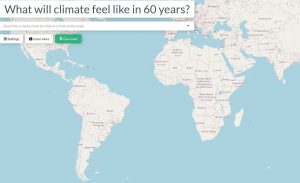Geography/Environmental Studies 339
New WI chapter
Learning Objectives
By completing this chapter, you will:
- Be able to describe the changes in precipitation and temperature in Wisconsin that have occurred over the past 75 years;
- Be able to describe the predicted changes in precipitation and temperature in Wisconsin to the mid century;
- Investigate the effect of these changes on one of four issues important to the state: agriculture, human health, water resources/infrastructure or natural communities; and
- Outline the strategies that can be taken by state government, local government, and civil society to reduce negative impacts on the issue assigned to you.
So far, you have learned how climate change will affect distant places like Bangladesh. But what are the specific impacts expected in Wisconsin? In this chapter, we turn to the effect of climate change on Wisconsin and strategies to adapt to the changes that we have experienced and are likely to experience over the next 40 years. We will start by first reviewing changes in precipitation and temperature that we have experienced and what is predicted we will experience over the next forty years. We then turn to how these changes are expected to affect both the state’s and Dane County’s agriculture, human health, water resources/infrastructure, and natural communities. In section, each of you have been assigned to investigate one of these important issue areas by using the links supplied in this chapter. These links will also provide ideas of how we can reduce climate impacts on these sectors and increase our adaptive capacity to respond to climate changes. Using the resources we provide, you will be expected to fully investigate your topic area prior to class when you will be tasked in small groups to share your sector knowledge and to discuss a common case that will be provided to your in section. You will be the only member of your group to have investigated your assigned sector so come prepared because your group will depend on you!
Changes in Wisconsin’s Climate
Three key climate parameters affecting ecology, economy and human health in Wisconsin are temperature, precipitation, and season length. A great resource is the website of the Wisconsin Initiative for Climate Change Impacts (WICCI) that was developed by a range of climate change experts here in Wisconsin with many of them faculty or staff here at University of Wisconsin-Madison. Start with this overview video, considering the following questions as you watch:
- How have climate factors like temperature, precipitation and season-length changed in Wisconsin?
- How are they predicted to change into the future?
 You now have a good general idea of the trends Wisconsin has already experienced and will undergo in the future. More detailed information is provided in a series of maps on the WICCI site. To access these maps, first open the WICCI webpage and then scroll down the bottom portion of the webpage to look at the historical trend maps (1950-2024). If you like, you can enlarge a map by clicking on it. Please note that “DJF” refers to December, January, February (Winter months), “JJA” refers to June, July, August (Summer months), “SON” refers to September, October November (Fall months) and “MAM” refers to March, April May (Spring months). Please review these maps and answer the following questions.
You now have a good general idea of the trends Wisconsin has already experienced and will undergo in the future. More detailed information is provided in a series of maps on the WICCI site. To access these maps, first open the WICCI webpage and then scroll down the bottom portion of the webpage to look at the historical trend maps (1950-2024). If you like, you can enlarge a map by clicking on it. Please note that “DJF” refers to December, January, February (Winter months), “JJA” refers to June, July, August (Summer months), “SON” refers to September, October November (Fall months) and “MAM” refers to March, April May (Spring months). Please review these maps and answer the following questions.
 Scroll down further to look at climate projections out to the 2041-2060 period. Please review these maps and answer the following questions:
Scroll down further to look at climate projections out to the 2041-2060 period. Please review these maps and answer the following questions:
Once you have completed your review (taking notes!) of the resources, you are finished with this chapter. Please bring your notes and responses to the assignment questions with you to your discussion section!
(c) Dennis Franke
nationally determined contributions

 A new tab should open resembling the image to the right. Please explore the map by typing the name of the closest city to where you grew up. A line will be drawn to a city that currently has a climate most similar to the projected climate to the city you chose. This is the projection under a continued high GHG emissions trajectory. Now, click on the Settings and choose the “What if we reduced emissions Scenario” which is similar to the reductions stemming from achieving all of the
A new tab should open resembling the image to the right. Please explore the map by typing the name of the closest city to where you grew up. A line will be drawn to a city that currently has a climate most similar to the projected climate to the city you chose. This is the projection under a continued high GHG emissions trajectory. Now, click on the Settings and choose the “What if we reduced emissions Scenario” which is similar to the reductions stemming from achieving all of the